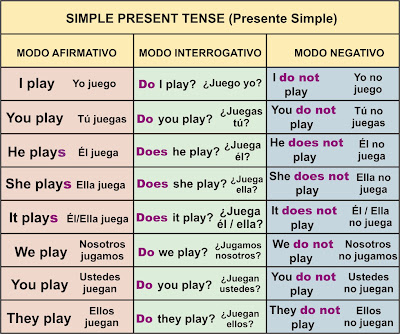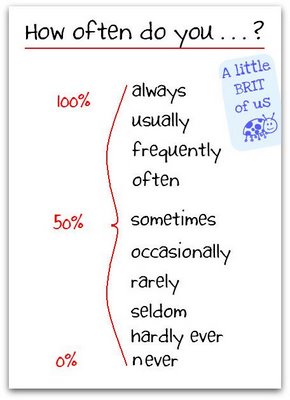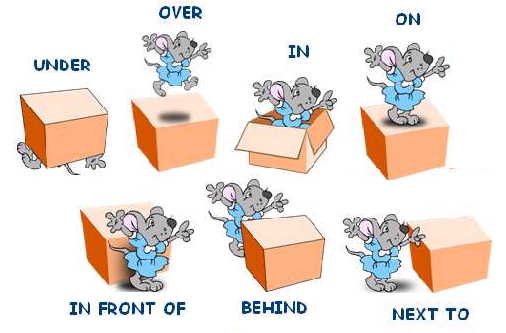TOPICS
INTRODUCING YOURSELF!
- Hello, my name is... (Hola, me llamo...)
- Pleased to meet you. / Nice to meet you. (Encantado / Mucho gusto)
- How are you? (¿Cómo estás?/¿Qué tal?)
- What's happening? / What's up? (¿Qué pasa?)
- I'm fine, thank you. (Estoy bien, gracias.)
- And you? (¿Y tú?)
- How old are you? (¿Cuántos años tienes?)
- I am ... years old. (Tengo ... años.)
- Where are you from? (¿De dónde eres?)
- Where do you live? (¿Dónde vives?)
- What do you do? / What do you do for a living? (¿Qué haces? / ¿En qué trabajas?)
- Do you speak Spanish? (¿Hablas español?)
- Excuse me. (Perdón.)
- I don't understand. (No entiendo.)
- Can you repeat, please? (¿Puedes repetir por favor?)
- Can you speak slower, please? (¿Puedes hablar más despacio por favor?)
- Thank you very much! (¡Muchas gracias!)
- You're welcome. (De nada.)
- See you later! (¡Hasta luego!)
- Have a nice day! (¡Que pase un buen día!)
- Same to you.
—————
TO BE VERB - Simple Present Tense
El verbo TO BE, que en castellano se traduce como SER o ESTAR, en el idioma inglés goza de una particular importancia. Su significado depende del sentido de la oración. Por ejemplo:
- I am a doctor. Soy un doctor. (Se aplica como verbo ser)
- I am in my house. Estoy en mi casa. (Se aplica como verbo estar)
En el siguiente cuadro se puede observar su declinación en el modo indicativo del Presente Simple.  Tanto en el modo afirmativo como en la forma negativa pueden utilizarse las siguientes contracciones:
Tanto en el modo afirmativo como en la forma negativa pueden utilizarse las siguientes contracciones:

—————
SIMPLE PRESENT TENSE
El Presente Simple es un tiempo verbal que se utiliza para describir acciones habituales que suceden con cierta frecuencia y no hace referencia a si está ocurriendo en el momento actual.
- I play tennis. Yo juego al tenis.
- He works in an office. Él trabaja en una oficina.
A continuación se muestran las formas afirmativa, interrogativa y negativa de este tiempo verbal:

En el cuadro superior se ha tomado como ejemplo el verbo PLAY (jugar). Observe que en el modo afirmativo, en la 3º persona del singular, se le añade una “S” al verbo.
- He eats vegetables. Él come vegetales.
- Alice dances at the theatre. Alice baila en el teatro.
- The dog breaks the fence. El perro rompe la cerca.
En el modo interrogativo y negativo se utiliza el auxiliar DO, aunque en la 3º persona del singular se coloca como auxiliar DOES y se le quita la “S” al verbo.
Existen algunos casos particulares como por ejemplo, si el verbo empleado termina en “SS”, “SH”, “CH”, “O” y “X” al formar la 3º persona del singular en la forma afirmativa se le agrega “ES”. Aquí vemos algunos ejemplos:
- Si el verbo es FISH (pescar), se conjugará: He fishes at the sea. Él pesca en el mar.
- Si el verbo es KISS (besar), se conjugará: She kisses to her boyfriend. Ella besa a su novio.
- Si el verbo es WATCH (observar), se conjugará: He watches the mountain. Él observa la montaña.
- Si el verbo es FIX (arreglar), se conjugará: He fixes his car. Él arregla su coche.
- Si el verbo es GO (ir), se conjugará: She goes to the office. Ella va a la oficina.
Otra excepción se presenta si el verbo termina en “Y” tras consonante. Para formar la 3º persona del singular se sustituye esta “Y” por una “i” acompañada de la terminación “ES”. Por ejemplo:
- Si el verbo es STUDY (estudiar) se conjugará: She studies the lesson. Ella estudia la lección.
Para la forma negativa se puede emplear la forma contraída de DON’T en lugar de DO NOT o DOESN’T en vez de DOES NOT.
- I don’t play tennis. Yo no juego al tenis.
- He doesn’t work in an office. Él no trabaja en una oficina.
- They don’t travel to Madrid. Ellos no viajan a Madrid.
SHORT ANSWERS:
- Do you play tennis? Yes, I do. or No, I don't.
- Does she work in a Bank? Yes, she does. or No, she doesn't.
—————
ARTICLES: A/AN - THE
A, An or The?
When do we say "the dog" and when do we say "a dog"? (On this page we talk only about singular, countable nouns.)
The and a/an are called "articles". We divide them into "definite" and "indefinite" like this:
| Articles | |
| Definite | Indefinite |
| the | a, an |
We use "definite" to mean sure, certain. "Definite" is particular.
We use "indefinite" to mean not sure, not certain. "Indefinite" is general.
When we are talking about one thing in particular, we use the. When we are talking about one thing in general, we use a or an.
Think of the sky at night. In the sky we see 1 moon and millions of stars. So normally we would say:
- I saw the moon last night.
- I saw a star last night.
Look at these examples:
| the | a, an |
|
|
Of course, often we can use the or a/an for the same word. It depends on the situation, not the word. Look at these examples:
- We want to buy an umbrella. (Any umbrella, not a particular umbrella.)
- Where is the umbrella? (We already have an umbrella. We are looking for our umbrella, a particular umbrella.)
CLICK HERE to practice.
—————
MY DAILY ROUTINE
En la rutina diaria encontramos todas aquellas actividades que realizamos dia a dia.
Por ejemplo:
- I get up at 7 o'clock every day. (yo me levanto todos los dias a las 7 en punto)
- I have dinner at 10 p.m (Yo ceno a las 10 pm)
Cuando hablamos de nuestra rutina diaria, usualmente usamos los FREQUENCY ADVERBS o adverbios de frecuencia; los cuales nos indican que tan a menudo realizamos dichas actividades.
- I always take a shower before having breakfast.
- I never do homework

CLICK HERE to practice
—————
DEMONSTRATIVES - THIS/THAT/THESE/THOSE
Los demostrativos this, that y sus formas de plural these, those no suelen crear problemas a los estudiantes de inglés más allá de las confusiones entre la forma del singular y la del plural, sobretodo delante de sustantivos que tienen un plural irregular.
Forma:
Singular (cerca): this /ðɪs/ Plural (cerca): these /ðiːz/
Singular (lejos): that /ðæt/ Plural (lejos): those /ðəʊz/
Uso:
- this / these se utilizan para hablar de objetos o personas que están cerca del locutor:
Can I have this piece of cake?
What are these shoes doing in the middle of the room?
- that /those se utilizan para hablar de objetos o personas que están lejos del locutor:
- Can you pass me that dictionary over there?
- Who are those people on the other side of the street?
Importante:a. Recordad que los siguientes sustantivos son plurales irregulares en inglés, por lo tanto los demostrativos que los acompañan serán these / those:
- children, men, women, people
b. Los demostrativos this / that (these /those) pueden ser también pronombres:
- This costs more than that.
- These are my children.
c. En una conversación telefónica, this se utiliza para identificar a la persona que está llamando, mientras que that se utiliza para identificar a la persona que recibe la llamada:
- Hello. This is Jerry. Is that Tom?
CLICK HERE to practice.

—————
THERE IS - THERE ARE
Las expresiones there is y there are se utilizan en inglés para indicar que un objeto o una persona se encuentran en un sitio especificado.
- There is a book on the table.
- There is an apple in the basket.
Observa que el sustantivo lleva el artículo idenfinido (a/an). Normalmente no se utiliza el artículo definido the con there is:
- There is some tea in the pot.
- There is ice on the street.
2. Utilizamos there are cuando el sujeto es:
- There are two apples in the basket.
- There are 3 chairs in the room.
La forma negativa de las expresiones existenciales there is / there are se construye con la partícula negativa not:
- There isn’t any apple in the basket.
- There aren’t twenty children in the class.
La forma interrogativa se construye mediante una inversión entre el verbo to be y el sujeto “postizo” there:
- Is there an apple in the basket?
- Are there twenty children in the class

CLICK HERE to practice
—————
PREPOSITIONS
Prepositions are important when constructing sentences. A preposition sits before a noun to show the noun's relationship to another word in the sentence.

—————
COMPARATIVES & SUPERLATIVES
Los comparativos sirven justamente para comparar una misma cualidad o característica en dos sustantivos.
Para formar el comparativo, se deben seguir las siguientes reglas:
- Se agrega al adjetivo "er" o "r", si ya termina en "e".
small - smaller - Si la palabra termina en vocal + consonante, se duplica la consonante.
big - bigger - Si termina en "y" se cambia por "ier".
happy - happier
Cuando el adjetivo tiene más de tres sílabas, el comparativo se forma usando la palabra "more" adelante.
expensive - more expensive
careful - more careful
Para comparar dos objetos en una oración, se agrega "than".
- This shirt is smaller than that shirt.
Los superlativos sirven para referirse a sustantivos que son los únicos que presentan una cualidad que los diferencia del resto.
Siempre se agrega "the" adelante. Para formar el superlativo, se deben seguir las siguientes reglas:
- Se agrega al adjetivo "est" o "st", si ya termina en "e".
small - the smallest - Si la palabra termina en vocal + consonante, se duplica la consonante.
big - the biggest - Si termina en "y" se cambia por "iest".
happy - the happiest
Cuando el adjetivo tiene más de tres sílabas, el superlativo se forma usando las palabras "the most" adelante.
expensive - the most expensive
careful - the most careful

CLICK HERE to practice
—————
PRESEN PROGRESSIVE TENSE
The present progressive is used for actions going on in the moment of speaking and for actions taking place only for a short period of time. It is also used to express development and actions that are arranged for the near future. Present progressive is also known as present continuous.
Use a form of to be and the infinite verb plus -ing.
- am with the personal pronoun I
- is with the personal pronouns he, she or it (or the singular form of nouns)
- are with the personal pronouns you, we, they (or the plural form of nouns)
CLICK HERE to practice
—————










